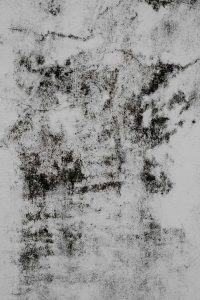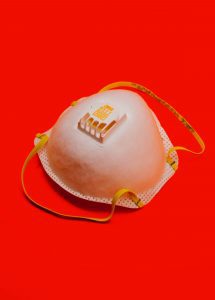Cleaning and Removing Mold in Your Home
Authors: Mary Ellen Welch and Stacey Stearns
Mary.Welch@uconn.edu
Reviewers: Katherine Allen, University of Florida; Samantha Kennedy, University of Florida; and Faye Griffiths-Smith, UConn Extension
Publication August 2024 | EXT028
https://doi.org/10.61899/ucext.v1.028.2024
Introduction:
Mold grows in wet, damp conditions, and in homes can form after flooding or water leaks. Humid areas in the home are another prime location for mold to
grow; kitchens and bathrooms are thus especially susceptible to its growth. Mold in the home can cause health issues, and it is important to remove it quickly and carefully. Once present, with continued water or moisture exposure, mold will continue to grow quickly. Dry an area and keep it dry.
Mold can grow on many surfaces, including walls, clothing, carpets, and in the spaces under carpets, between walls, attics, and basements, damaging building materials and furnishings. Look for discolored patches, including red, black, blue and green; it can also appear slimy or fuzzy.
Sometimes mold is visible, or residents notice a musty smell. Unfortunately, mold spores can be invisible to the naked eye. Therefore, those with water damage, a flooded home, or musty smell should assume that mold is present. Fix the leak or remove the water in the area and begin cleaning and removing the mold as soon as possible. Discard any building materials, including drywall and carpet, that are wet for more than 24 hours.
Negative health impacts from mold are common and are another reason it is crucial to avoid mold in homes, offices, and other locations. Common symptoms of mold allergies or sensitivities include headaches, coughing, wheezing, a runny nose, watery eyes, and itching. Children and people with compromised immune systems are at a greater risk of negative health impacts from mold. Long-term exposure can lead to more serious health issues.
Avoid mold through preventative measures, including keeping the humidity in the home below 50 percent (perhaps with the use of a dehumidifier), by fixing leaks, and cleaning regularly, especially the areas susceptible to mold growth. Exhaust fans in the kitchen and bathroom that vent to the outside are essential. Using a dehumidifier in the basement or other humid locations also reduces the risk of mold growth.
Removing Mold in the Home:
After flooding or water leaks in the home, assume that there are mold spores; look closely for them and remove them. Cleaning should be done as quickly as possible to minimize the potential for damage to materials and make the home safe to live in again. Alcohol and hydrogen peroxide are common mold cleaning agents.
Contractors licensed in mold remediation can be hired. The cost varies depending on the contractor and the extent of mold damage. Check with your homeowners’ or renters' insurance company prior to cleaning, and document all damage. Renters should check with the landlord as to who is responsible for mold cleanup and removal.
Residents removing mold on their own should think of their health and safety first. Anyone with asthma, allergies or related chronic respiratory conditions should not remove and clean items contaminated with mold and other contaminants carried in flood waters. Children and people with immune system issues may be more likely to be impacted negatively, so they should not be present during clean-up.
See what is and is not covered by your insurance company and check the deductibles. Ask for references from the insurance company representative for contractors who are licensed to perform remediation.
Here are some best practices for dealing with mold in the home:
- First, wait until floods have receded. Get in touch with homeowners or rental insurance company. Contact the landlord. Ask about resources available in the local area, through the town, county, and state.
- Take photos and videos of the damaged property before removing anything.
- Use an N95 respirator along with gloves and goggles for protection from mold spores that may be dispersed through removal and cleaning. These are
recommended to minimize negative health impacts. Take frequent breaks in the fresh air as well.
- Wear protective clothing such as long sleeve shirts, full length pants, boots, and a hat. It is possible to be injured so bring a first aid kit with bandages.
- Consider getting a dumpster to discard wet and moldy materials. Carpets, cardboard, fabrics, and mattresses that are wet and damaged with mold should be discarded. It is hard to clean and remediate these items and better to discard and replace them. This includes plaster walls and insulation as well. It is possible that washing clothing may make it usable again. The American Cleaning Institute offers resources for cleaning laundry after a flood.
- Clean the home. Select products that are unlikely to cause an allergic reaction for you or your family members. Read labels and use cleaning and disinfecting products safely in the right measurements. Most moldy materials and items should be discarded. Glass, wood, plastic, cement, and other solid surfaces can be cleaned after a mold infestation. Use a HEPA-filter vacuum then use a cleaning agent. Alcohol and hydrogen peroxide are common mold cleaning agents and may help you rescue books which may be salvaged.
- Ventilate the area using fans to push any remaining mold spores out of the home.
- Dry the area. It is important to thoroughly dry the area, lowering humidity levels to between 30 and 50 percent. This can be done with dehumidifiers or with a combination of an air conditioner and heater. Turn these off when you leave the home. Prevent the area from getting too cool as condensation will fuel further mold growth.
- Stay alert for more mold growth. Cleaning moldy areas is hard and removing all spores is challenging. Keep the area clean and dry and wait to move materials (furniture or other objects) back into the space until you are sure that mold growth has stopped; some people may still have an allergic reaction to dead mold spores.
Resources
American Cleaning Institute. (n.d.). Cleaning after a flood or emergency. Available at https://www.cleaninginstitute.org/cleaning-tips/clean-home/cleaning-after-flood-or-emergency
Connecticut Department of Public Health. (n.d.). A healthy home is clean. Available at https://healthyhomes.media.uconn.edu/wp-content/uploads/sites/1344/2022/02/Healthyhome_clean_3-1-12.pdf
Harrison, M.N., Cantrell, R.A., & Griffin, A. (2021, October 7). Keeping it clean: Controlling mildew. University of Florida IFAS. Available at https://edis.ifas.ufl.edu/publication/FY796
Reichel, C.H. (n.d.) Storm Damage cleanup highlights. LSU AgCenter. Available at https://www.lsuagcenter.com/profiles/kkramer/articles/page1471624895743
U.S. H.U.D. (n.d.). Everyone deserves a safe and healthy home. Healthy Homes Project; U.S. Department of Housing and Urban Development. Available at https://www.hud.gov/sites/documents/SAFEANDHEALTHYHOME.PDF
The information in this document is for educational purposes only. The recommendations contained are based on the best available knowledge at the time of publication. Any reference to commercial products, trade or brand names is for information only, and no endorsement or approval is intended. UConn Extension does not guarantee or warrant the standard of any product referenced or imply approval of the product to the exclusion of others which also may be available. The University of Connecticut, UConn Extension, College of Agriculture, Health and Natural Resources is an equal opportunity program provider and employer

